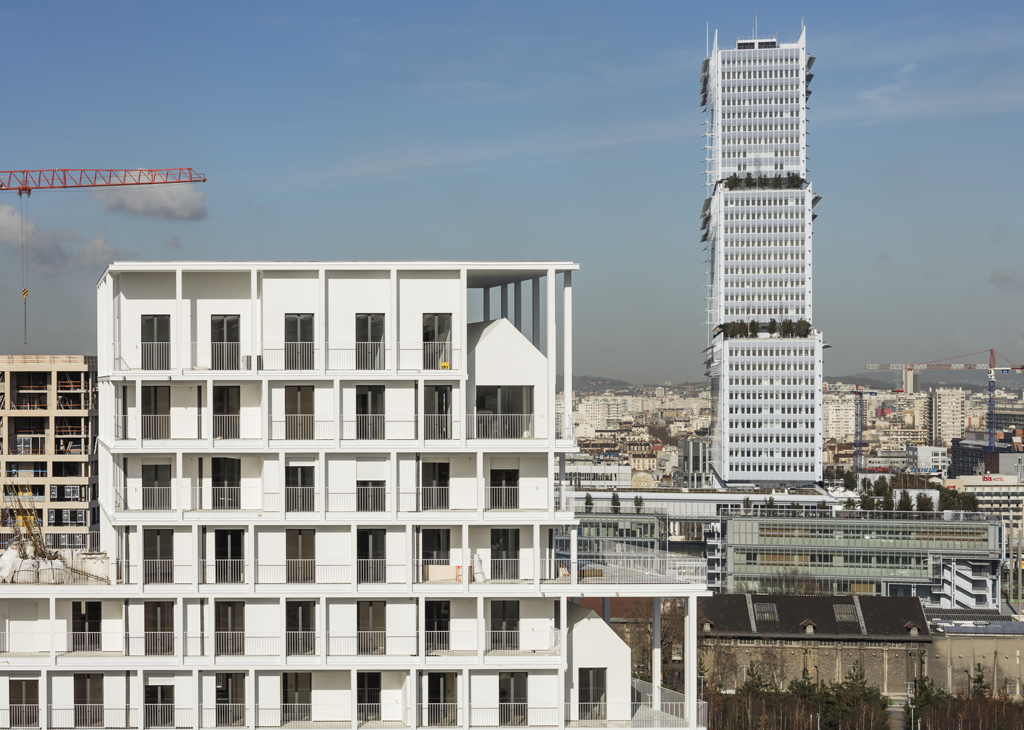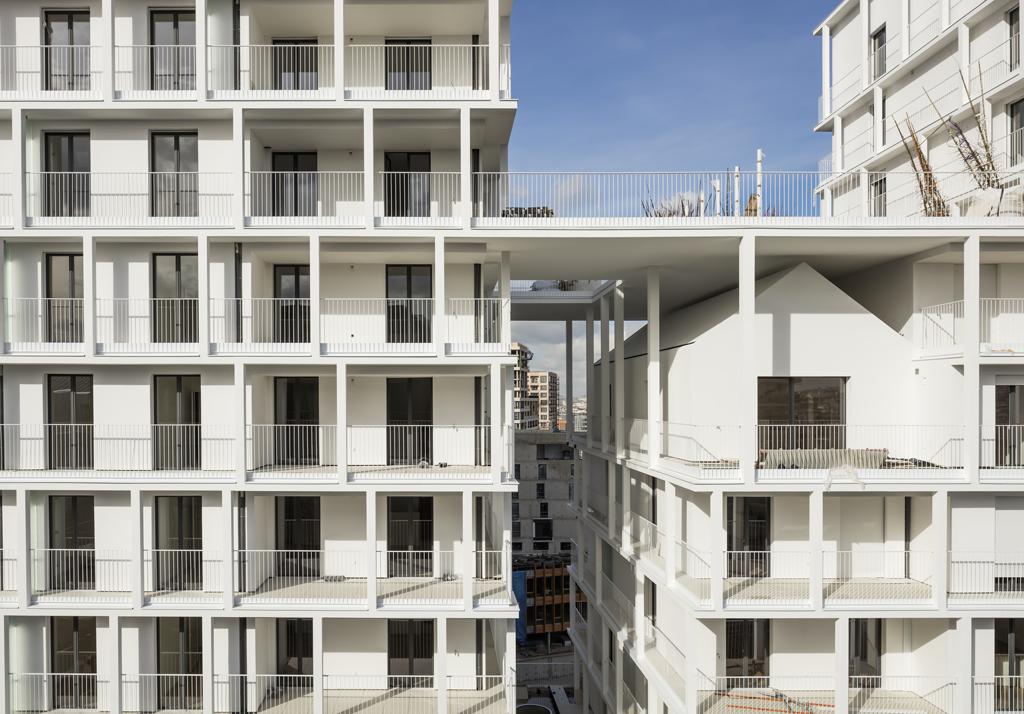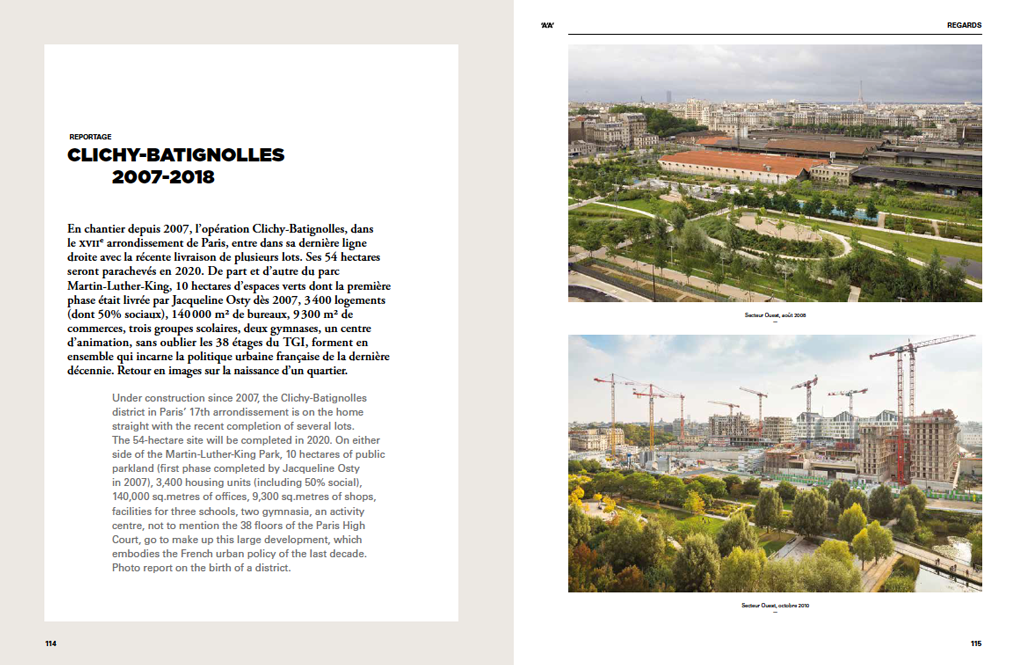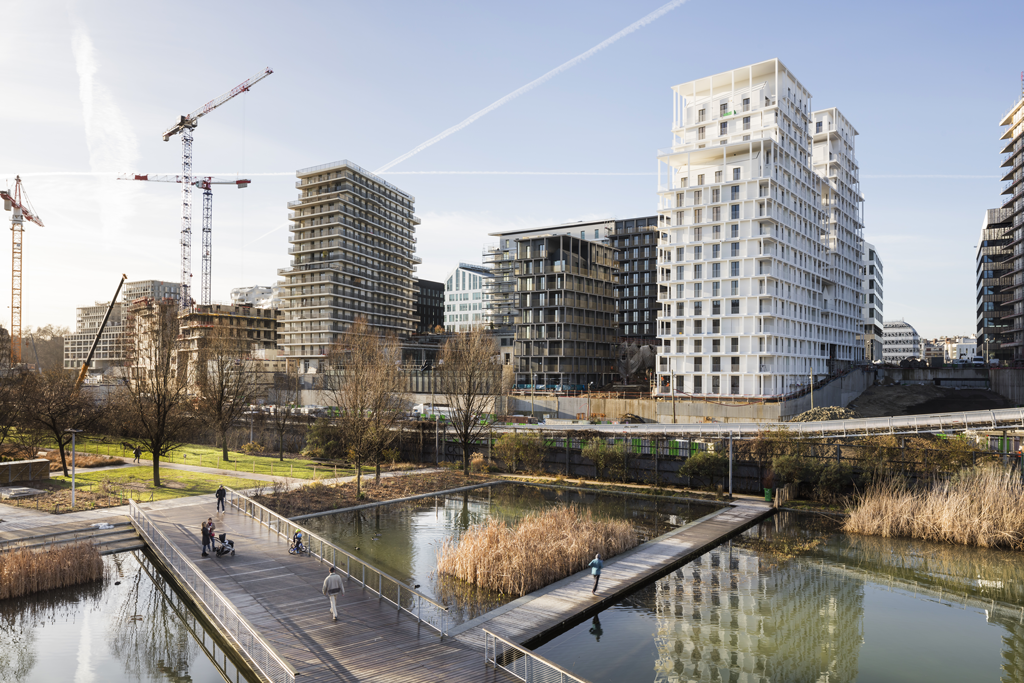Draw me a flat
This article by Olivier Namias was originally published in AA’s 428th issue – Private commissions, public intentions – released in December 2018.
In the Clichy-Batignolles development zone, a major urban development project located in the Northwest of Paris, a building stands out with its white exoskeleton. Despite its unusual size, there is nothing to say looking at the exterior. But inside, there are too many partitions and ill-placed corners. These apartments are aimed more at being sold than being lived in. The architects do not recognise the project their offices have designed. But did they really draw it? Illustrating the conflicts between public interest and the interests of private developers, the Émergence building is a good case study of how the contemporary city is built.
Act I: Arranged union and great density
Since 2010, the Batignolles railway landtake in Paris has been the subject of an ambitious development project. Urban planner François Grether and landscape designer Jacqueline Osty drew up the plans of a 54-hectare ecodistrict to be completed within 10 years. Just as the first phase rose out of the ground and the second phase got underway, the city decided on a workshop system instead of a competition-style consultation producing a collection of solitary objects. Another idiosyncrasy lied in the choice of the city to impose the architect upon the developers, who could not just walk in with their own architect. Paris Batignolles Aménagement (PBA), the public development company in charge of the area, had nine lots in phase 2. They divided up lot number O4 among social landlord Paris Habitat (lot O4A, 4,600 sq. metres) and property developer Kaufman & Broad (lot O4B, 3,200 sq. metres). It was a big construction site and an unusual one for this developer, whose image of being an expert in supposedly Haussmannian architecture is seen as conservative, if not outdated. They agreed to work with a mixed team of architects from the Paris-based Atelier d’Architecture Vincent Parreira (AAVP) office and the Lisbon office Aires Mateus. As is often the case with arranged unions, the partners did not know each other very well, and in this case, Kaufman & Broad poorly measured the stature of renowned architects Aires Mateus.

Act II: Figures never lie
The programme involved the construction of 170 apartments, of which 50 where to be sold off-plans to a social landlord. In’li targets middle-class tenants eligible for the higher band of social housing. The intention is to house a population which, despite its income, has difficulty in finding housing in Paris. This part of the programme can be identified by its black colour and gold outfitting of superstructures. AAVP and Aires Mateus chose to assemble the housing on either side of the lot, leaving room for a real garden linking the Martin Luther King Park and the Mstislav Rostropovich street. They dissected the various regulations in order to optimise the construction and the volumes. The final project planned the construction of two plots to the East of the site, dedicated to the social housing programme. The private apartments were located in three plots very close together, separated by two narrow breaks allowing ventilation and natural light to enter the utility rooms. Making good use of a height restriction waiver, the plots at either end rose up to 15 floors above the ground floor. Emerging to this height, the project was named Emergence. For the architects, the block plan and the concentration of the apartments in a 15-metre-thick band helped to design a real garden and opened up a splendid view. From the apartments, one can look at the neighbouring Paris High Court, the Sacré-Coeur and the Eiffel Tower. A balcony framework recreated an exoskeleton surrounding the apartments. Thus designed, the AAVP/Aires Mateus project developed a floor area of 12,400 sq. metres. The figures did not add up for the property developer, who was concerned about the marketable area ratio created per built metres squared. In his opinion it was too low: 0.8 against a usual 0.93, a figure that seems unrealistic to many architects. Less also than the parcel notice, allowing the construction of 13,000 sq. metres (1), i.e. an additional 600 sq. metres, reaching a floor area ratio of 4, approaching the density of Haussmannian Paris. This difference gave the property developer a real case to plead. For Kaufman & Broad, this change in area would have to be compensated by a drop in the plot prices. However, for the public development, lowering the plot price would be damaging to their balance sheet. They had to wait for a released price to achieve a balance. Project changes seemed inevitable, even more according to the developer who thought the break created apartments that were difficult to adapt and that didn’t match his standards.

Act III: Bad plans
Most of the changes affected the private parts of the project, located in a continuation of three white blocks occupying the North-West boundary of the plot. The filling of a break, believed important for the project identity, seemed like a good way to win back some lost square metres, especially as the “plugging of the break” eliminated a vertical distribution. This implied a complete reconfiguration of the apartments, in groups of four around each staircase. Out went the double aspect and the secondary views for some of them, even though the floor is 15 metres thick. The architects began to review their plan as best they could, submitting it to their client in March 2012. It was a provisional plan, partially completed, which needed to be refined with the property developer. Then the latter disappeared, without answering any of the architects’ various letters and calls. When he reappeared, six months later, he presented his own modified plans at a meeting as being authoritative. After all, the AAVP/Aires Mateus duo did not have the construction mandate on this type of project and had not the property developer made it clear to the architects that he believed them to be incapable of drawing an apartment plan? Crooked doors and corners appeared on the revised floors and the apartments were reorganised according to the day and night plan, a proven recipe of the post-war years. “A project often resembles its client. In private property development companies such as Kaufman & Broad, we often feel that the project managers reproduce their own lifestyle and family model in their projects, which is basically a couple living with school-age children, which inevitably leads to separating the bedrooms and bathroom from the living room. As far as we are concerned, we believe that there is a broader range of lifestyles and occupants, and that they are very different from the typical family model. One room could become an office when the children have left the nest, or a couple without children could wish to have a bigger living room even if it meant getting rid of the bedroom”, explains Vincent Parreira. Even the property developer’s website displays different profiles, showing a single man, a senior, a single mother, first-time buyers… A variety that Kaufman & Broad does not seem to favour in their plans. One of the corrected plans even shows an improbable bathroom, in which there are his and her wash basins, suggesting a well-known formula: a family requires a father and a mother. Is this really reflective of modern society? This raises the question of sociological bias and not just in this specific case.

Outcome: City and property developer
Three months after revealing their plan, Kaufman & Broad changed it again. This time it affected the integrity of the design and in particular the exoskeleton. The detailed plan of the way the floors and posts meet, fundamental for the structure and appearance of the façade, was subjected to a very detailed development. “The project hinges on two main entities: an exoskeleton made of offset posts, placed in front of the peripheral walls of the apartments. The alignment of the windows, which is rigorously identical on all levels, and the floor-nosing maintains a balance in how the building is perceived. We believe that anything random must be balanced by a strict layout”, says Éric Crochu, AAVP’s project manager. The client did not pay much attention to this arrangement. Kaufman & Broad asked that the windows be moved to fit the new plans and even removed the surrounding balcony in some areas. They refused to change the position of the apartments’ façade, which, thanks to the exoskeleton, could allow for some movement to incorporate changes to the apartments. Stuck in an intermediary state, the plans of the apartments, cobbled together to adapt to an inadequate envelope, have unusable corners that would have been easy to absorb. In a city like Paris, in which land development pressure is so strong, the City can, by means of building permits, pressure property developers to remind them of their obligations. Here, the City has encouraged the property developer to redesign the exteriors, which are given to the community and the city by the client. It did not intervene, however, in the private sphere, probably believing that beyond a certain income, each person is free to buy an apartment, whether it is wonderful or mediocre. In the words of Manuel Aires Mateus, for whom this was the first experience in building private multi-family housing in France: “Here, housing design follows rules and is not guided by the architect. The design workshops organized in the Batignolles district focused primarily on the image of the project and much less on the quality of the housing. We would like to explore this question of quality in other French projects and find ways of evading the issue while adhering to the rules. We would like to open up the housing production system to provide greater freedom.” Since the completion, Kaufman & Broad’s President has been replaced. Will the new one show interest in such experimentations?

(1) Of which there are 8,700 sq.metres of private apartments, 3,800 sq.metres of middle-rent rental housing, 500 sq.metres of shopping areas and 125 parking spaces.
AA’s 428th issue – Private commissions, public intentions – is available on our online store.
In its 423th issue – Architecture in the making – AA offered a photo report on the Clichy Batignolles district’s evolution between 2007 and 2018. Click on the image below to read the whole article.



